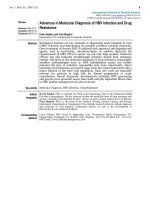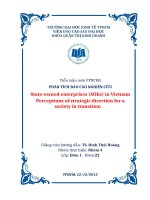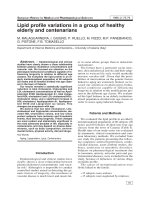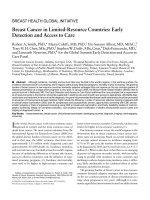Potential Actual Opioid Diversion in Vietnam, Methods of Preventing Diversion, and Barriers to “Balance”
Bạn đang xem bản rút gọn của tài liệu. Xem và tải ngay bản đầy đủ của tài liệu tại đây (203 KB, 9 trang )
Potential & Actual Opioid Diversion
in Vietnam,
Methods of Preventing Diversion,
and Barriers to “Balance”
Eric Krakauer, MD, PhD
Harvard Medical School Center for Palliative Care
Massachusetts General Hospital
Copyright © 2012 Eric L. Krakauer & Massachusetts General Hospital. All rights reserved.
1
Outline
• Background: Opioid use & abuse in Vietnam:
past & present
– Vietnamese opiophobia
• Prevention of diversion
– Laws & regulations
– Discretionary control of opioid prescribing by
healthcare leaders
• Evidence of diversion of controlled medicines
• Ways forward
2
History of Opioids in Vietnam …
• Opium trade controlled by French colonial
regime in 19th & early 20th centuries
– Major source of revenue
– Means of social control
– ”Village quotas”
• Opium trafficking by CIA 1950 – 1970s as
means of financing clandestine operations & war
(Laos)
• Heroin use by US & ARVN soldiers
• Current epidemic of injected heroin dependence
driving Vietnam’s HIV/AIDS epidemic
3
Illicit opioid use – now mainly injected heroin – is a
major problem in Vietnam: ~170,000 IDU
4
…History of Opioids in Vietnam
• Results:
– Profound cultural OPIOPHOBIA. Association of
opioids with Western tyranny and “social evils.”
– Negative language about opioids throughout
Vietnamese law.
– Strict regulatory control of opioid prescribing:
• Limits on prescribers:
– Right to prescribe, dose, duration
– Reluctance / refusal by healthcare leaders to
permit staff to prescribe opioids
• Limits on pharmacists
5
Opioid Availability in Vietnam:
Progress through partnerships and policy reform
• Before 2008
–
–
–
–
–
–
–
Max Rx period 7 days
Max Rx 30 mg/5 days
No CA/AIDS=no opioid
Records 5 years
Insuff IR morphine
Limited pt access
No guidelines
– Inadequate PC training
– Hospital directors decide
who can Rx
• Starting in 2008
–
–
–
–
–
–
–
–
–
30 days
No max dose
No CA/AIDS=7 day Rx
2 years
Increased domestic mfg
District avail. plan
MoH PC guidelines
MoH PC Train Program
Hospital directors still
decide who can Rx
6
Recent Evidence of Diversion of
Controlled Medicines
• 2000: 2 nurses at National Cancer Hospital
(Hanoi) sentenced to 2 years in prison for
collecting ~100 dispensed but unused vials of
diazepam, selling it to private pharmacies.
• 2006: 2 pharmacists from Kien Giang Province
sentenced to 7 years in prison for stealing
ketamine & selling it to interested individuals.
• No confirmed reports of opioid diversion.
7
Results of Diversion of Controlled
Medicines
• Changes in regulatory policy:
Diazepam briefly classified as “narcotic:”
Very secure storage
Restrictions on prescribing that limited access
(It is now considered again a psychotropic drug with less strict
regulations for storage and prescribing.)
• Prison terms for all diverters
• Probably greater fear among MDs that they will
be held responsible if a patient diverts.
At HCMC Cancer Hospital, rumor of a patient’s family
selling morphine –> Hospital Director reduced
maximum outpatient opioid prescription length to 5
days.
8
Ways Forward Toward Balance
• Avoid unnecessarily risky practices
– Eg.: Stocking morphine at HIV OPCs with no pharmacist.
• MoH certification in pain relief & pc
– Certified MDs should be able to prescribe opioids
– At least 1 – 2 MDs certified in pc at each district hospital
• Oral IR morphine available in all districts as planned.
• Scale-up palliative home care – health insurance must
cover home care.
• Opioid contracts required for patients with risk factors for
“dependence syndrome” or diversion.
• Routine monitoring:
– Of opioid consumption
– For diversion (models?)
9









